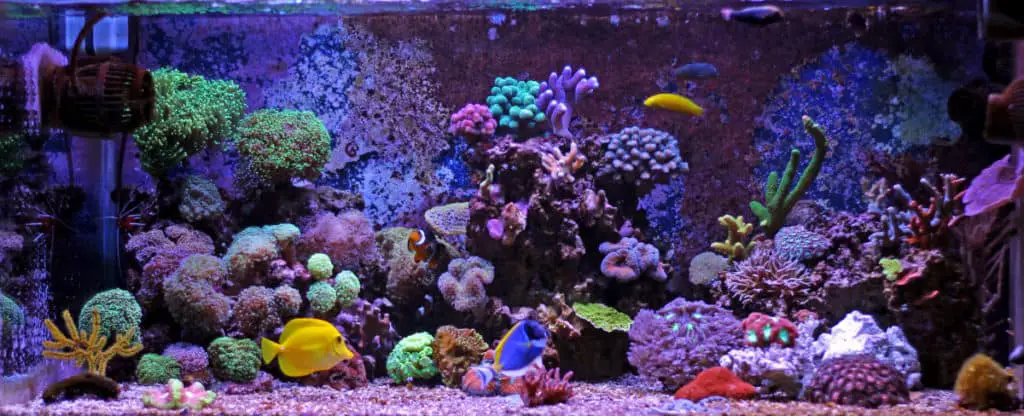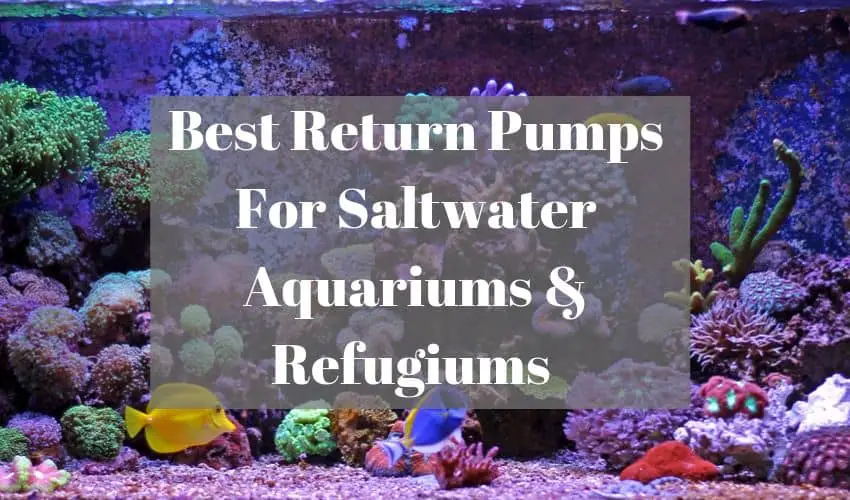It isn’t always easy to find the best return pumps for saltwater refugiums or aquariums. Which one is best can depend on a number of factors. What fish you keep, how much water you need pumping, and your budget will all play a part in your decision.
In order to help you wade through the myriad of options, we here at Fishkeeping Forever, have tested and reviewed a number of potential candidates. And here for your perusal are our choices of best return pumps for saltwater refugiums and aquariums.
Here are the TOP return pumps we reviewed & tested:
- VIVOSUN 400GPH Submersible Pump
- Jebao DCP Sine Wave Water Return Pump
- Aquastation DC-4000 Silent Swirl Controllable Pump
- VIVOSUN 800GPH Submersible Pump
- Hygger 1350GPH Quiet Submersible Pump

Table of Contents
What are return pumps used for?
A return pump is used to push water uphill during water filtration and to handle head pressure. They are generally used in reef aquariums where a sump is present. As water drains from your tank it moves into your sump through the filter process chambers and is
Types Of Return Pumps
There are four types of return pumps that can be divided into two categories; type of current and position they hold.
Type Of Current
AC – The most traditional type of return pump, an AC unit uses alternating current to spin the impeller at a constant rate. They have no built-in speed control and water flow is restricted by installing Valves that slow or divert some of the water. Many consider this a waste of energy as the pump uses more energy than it needs to.
DC – A far newer invention, the direct current water return pump uses far less electricity than an AC pump. It can be precisely controlled by a wired or wireless controller, runs cooler, and the low voltage is safer around water too.
Return Pump Position
Internal – The internal water return pump is designed to be submerged in the water. They are placed inside the sump, easy to install, and run incredibly well.
External – An external water return pump is designed to be installed outside the aquarium. They require plumbing in either to the filtration system or directly into the aquarium.
Top 5 Return pumps for saltwater Refugiums & Aquariums
VIVOSUN 400GPH Submersible Pump
Our thoughts…
My first attraction to this return pump was how fantastic it sounded on paper. It was multifunctional, suitable for use in aquariums, ponds, hydroponics, fountains, and had a compact design, and could be used in either wet or dry installations.
On opening the box, I indeed found the pump to be compact and also sturdily made. It fit into my tank with relative ease and was soon up and running. It moved the water well and with the aid of the oxygen nozzle provided, created a stream of oxygen negating the need for an air stone.
I have to say, however, that I have run other 400 GPH return pumps in my aquarium that seemed to produce better flow. The VIVOSUN, to me, seemed a little weak even on its highest setting.
Jebao DCP Sine Wave Water Return Pump
Our thoughts…
The Jebao return pump could be described as the king of the aquarium pumps. It has ten-speed settings controlled by a wired controller, feed delay button, and a ‘soft start’ motor. It also, and here is the real kicker, can be installed both internal and external with set up for both being child’s play.
I personally chose to install this pump externally to see how well it would work. I was pleasantly surprised as it ran efficiently with no leaks or production of heat. It also, and I can say with gusto, really could move some water. The control facility is also phenomenal with a setting suitable for every aquarium.
A quastation Silent Swirl
Our thoughts…
With an impressive flow rate of 660 GPH, the Aquastation Silent Swirl is another excellent return water pump for you to try. In fact, compared to the others, on paper at least, it has the most to offer for customization to your aquarium’s needs.
Once running the Aquastation has a great and strong water flow that you can control with its smart controller. There are an impressive 20 speeds to choose from plus an added bonus in the shape of a feeding mode. However, there are no adaptors included with this return pump meaning that the purchase of any you may need could really jack your expense up.
VIVOSUN 800 GPH Submersible Pump
Our thoughts…
Suitable for use in either wet or dry installations and featuring wet rotor/wet bearing technology this return pump is a real beast. It comes with three-outlet adaptors, has a water control valve, and is suitable for fountains, hydroponics, aquariums, and ponds.
I chose to use this return pump as a submersible which made installation extremely quick and easy. Once running, however, I immediately had doubts about this unit’s power. Don’t get me wrong, it worked and definitely moved my water around. However, it certainly did not do so with the power it suggested it has.
Hygger 1350 GPH Quiet Water Pump
Our thoughts…
On paper, the Hygger was definitely the most impressive return pump of the ones that we tested. It is, after all, different from the others, in that it has two kinds of removable water intake shells. This means, in simple terms, it can be used in water as shallow as 0.8 inches.
Other impressive features include the Hygger being ultra-quiet, having an auto shut off when no water is detected, and that it can be used internal or external. It is also easy to take apart, clean, and most importantly, put back together.
On using this pump, I have to say, it lived up to its reputation on paper. I could control the flow by choosing from 71 settings that ranged from 30% to 100% of its power. I could also pause the water flow which lasted for ten minutes. A useful feature when feeding your fish and leaving them to eat.

AC vs DC Water Pumps
In recent times DC pumps have increased in popularity. This is partly due to manufacturers pushing them forwards, and the control that they allow. Most DC pumps, you see, are able to be controlled with precision and have feed modes enabling them to be shut off should you need to do so. They are also a lot more energy-efficient making them fairly inexpensive to run.
Despite all the above, the DC return pump does also come with some disadvantages that may put you off. They have three main failure points, especially when used in saltwater aquariums, which are the controller, power supply, and motor.
By comparison, AC return pumps are a tried and true entity. They provide extreme reliability, often working for ten years or more, with the only failure point being the motor block.
Again, however, as with the DC return pump, the AC return pump comes with some disadvantages. Many do not come with an adjustable controller, they can be loud, and more generally prone to wear and tear.
Which is best: Internal or External
As we already know an internal return pump can only be run whilst submerged in water, whilst an external operates solely outside of it. They handle (external) pushing water over long distances due to their designs, whilst an internal cannot. They also, due to not being immersed in saltwater, tend to be far more reliable. Many of this type of pump will run for years without assistance.
Like anything, however, the external return pump does have some drawbacks. They are noisy making them quite irritating in your living room, and pretty expensive to buy.
How to choose the correct size pump
As a general rule of thumb, you should be looking for a return water pump that runs at 5 to 10 times the turnover of your aquarium. So, for an aquarium of 100 gallons, you will need a return pump of 500 to 1000 gallon per hour.
What’s our favorite return pump?
I don’t think you will be surprised to learn that our favorite return pump was the Hygger. This was due to a number of factors including power, high performance, the pause function, and its two types of water intake screens.
What is a refugium or sump tank?
Aquarium Sump – This is a separate tank that is plumbed into your display aquarium. It is usually found in a cabinet beneath the main tank or even down in a basement. They are usually divided into three different sections; drain, flex space, and return. Each one of these sections, when filled with sponge and chemical filtration, helps to keep your water filtered and clean.
Refugium – A refugium is a section in your sump that is reserved as a safe space for microfauna and microalgae in saltwater tanks. They come with many advantages such as:
- cultivating beneficial pods that your fish and coral will eat
- filtering out excessive nitrates and phosphates (macroalgae and live/dry rock needed)
- filtering out chemicals, phosphates, and nitrates (plants needed, freshwater only)
F.A.Q
- What size return pump do I need for my aquarium? The general rule of thumb is 5 to 10 times the turnover for the aquarium.
- What is a DC return pump? Return pumps come in two types; AC and DC. AC runs on alternating current whilst DC is direct current.
- How many times should a saltwater tank turn over? A healthy tank turnover rate is six to ten times per hour.
- Can you over filter an aquarium? Essentially no! However, too much water movement can stress fish.
- Is a sump better than a canister filter? Yes, absolutely. A sump holds more media and can use a bigger pump to force the water through the media at a faster rate. No filter setup is better than a sump setup.
Conclusion: Best Return Pumps For Saltwater Refugiums & Aquariums
After testing all five of the return pumps we chose to review, I can honestly say I would happily rely on any of them. However, my ultimate choice, and one I am currently using has to be the Hygger. It is reliable, powerful, quiet, and can be adjusted to suit my needs. It is everything you need in a return pump and you can’t ask for more than that!
- Comparing Aquarium Gravel To Sand – Which Is Best For Your Tank?
- Marineland Magniflow 360 Canister Filter 360 GPH | Pros and Cons
- Best Aquascaping Tools Every Aquarist Should Use
- Best Aquarium Plant Substrate Review 2022
- Polar Aurora Canister Filter | 2022 Updated Review 525 GPH

I have been working in the tropical fish industry for over 30 years now and I’m still learning. Everyday is a school day in this hobby. In my spare time I play golf very badly!












